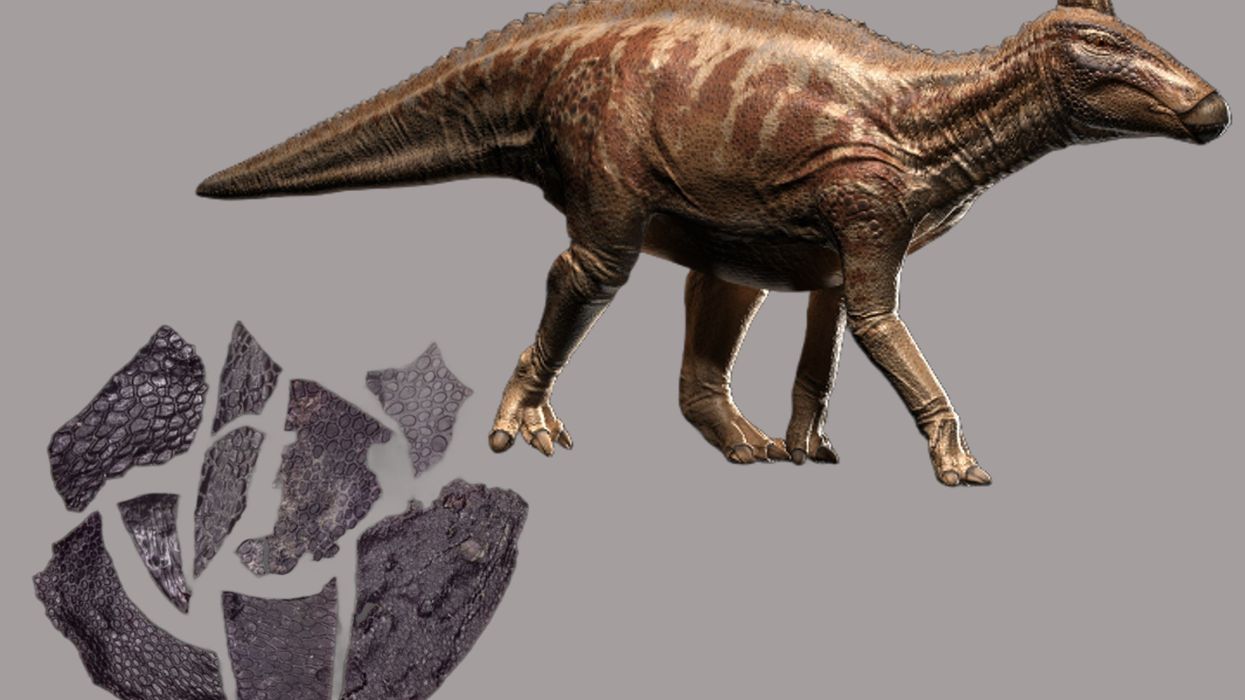Science & Tech
Harriet Brewis
Jan 17, 2024

The fossilised skin (left) was said to feature scales similar to that of the Edmontosaurus (right)
(Current Biology, Mooney et al/Wikimedia Commons)
The oldest fossilised skin ever discovered has been unearthed in the US, and it belongs to a beast that roamed the Earth well before the dinosaurs.
The skin dates back almost 290 million years – smashing the record held by the previous holder by a whopping 130 million years.
The specimen is described as having pebble-like, non-overlapping scales, which most resemble crocodile skin or that of the Cretaceous dinosaur Edmontosaurus, which lived between 145 and 66 million years ago.
"It was mind-blowing when we realised this was technically the oldest piece of a proper mummified skin," Ethan Mooney, a palaeontologist who co-authored a paper on the extraordinary find told Live Science.
"Impressions of skin are rare in the fossil record, but more common than proper mummified skin. Our skin cast (which is mummified skin), is 130 million years older than the oldest example of proper mummified skin."

The fingernail-size skin fragment was found in the Richards Spur limestone cave system in Oklahoma, US.
It was preserved thanks to a unique combination of fine clay sediments, oil seepage and an oxygenless environment within the cave system.
When researchers examined the fossil under a microscope, they found epidermal tissues that are commonly found in amniotes — a group of land-based vertebrates, consisting of reptiles, birds and mammals, that evolved from amphibian ancestors.
At the time this creature lived, dinosaurs were merely a twinkle in Mother Earth’s eyes. Instead, animals consisted of four-legged vertebrates which would have resembled crocodiles, lizards, eels and snakes.
Mooney told Live Science that these ancient ancestors would have looked "very reptilian if you saw them today," and that the "mummified skin and associated impressions likely show us what the skin would have been like in these ancestral reptiles."
However, given that no other related remains were found alongside the skin fossil, researchers haven’t been able to identify the species of its owner, or even what body part it came from.

Prior to this discovery, the oldest known fossilised skin came from a dinosaur, Mooney’s colleague, and the study’s lead author, Robert Reisz told Live Science.
He also noted the existence of another fossil from Russia that is 21 million years younger, but said this specimen needed to be reanalysed to confirm that it is, indeed, skin.
According to the Reisz and Mooney’s study, which was published last week in the journal Current Biology, the skin fossil is the oldest known example of a preserved epidermis – the outermost layer of skin on mammals, terrestrial reptiles and birds.
This dermal layer could have been vital to numerous species' transition from aquatic to fully land-based environments because it protected their organs from the elements.
Mooney said discovering fossilized skin resembling that seen in living animals today shows it was "critical for their success on land."
By enabling creatures to move from aquatic to terrestrial habitats, this early skin, and the novel structures within, helped prompt the evolution of birds, mammals and reptiles, he and his fellow authors wrote.
In other words, something as simple as reptile skin could have helped bring about the very existence of humankind.
Sign up for our free Indy100 weekly newsletter
Have your say in our news democracy. Click the upvote icon at the top of the page to help raise this article through the indy100 rankings
Top 100
The Conversation (0)













